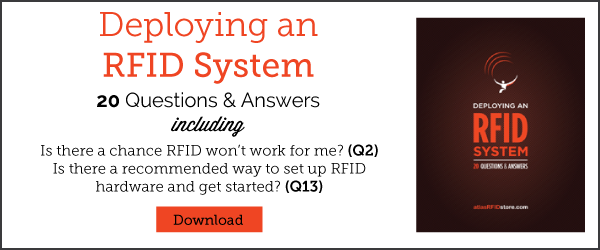General Purpose Input/Ouput (GPIO) Devices
Introduction
Most fixed RFID readers have a GPIO port, or General Purpose Input / Output port, that enables additional functionality, such as visual or audio signals. Unlike other ports on RFID readers, the GPIO port has only two settings – high (i.e. “on”), or nothing. The high signal acts as a trigger for GPO devices because it sends voltage through the port to trigger them to perform a certain action; likewise, an incoming high signal from a GPI device can act as a trigger the reader uses to perform a predetermined action.
What is a GPIO device?
A GPIO device is a device that performs actions based upon triggers sent by the RFID reader, providing additional functionality like audio or visual signals. Most fixed RFID readers have GPIO ports that allocate certain voltage levels to input and output electric signals. Within each GPIO port are several pins and each pin either outputs or inputs a trigger signal.
The number of pins in a GPIO port varies with the RFID reader, and it is important to note how many pins exist because most GPIO devices require 3, 4, or more pins in order to operate. It is also crucial to understand the amount of voltage each pin will provide to the GPIO device. Some readers’ GPIO ports do not allocate enough voltage to power a GPIO device. In those cases, even though the reader has a GPIO port, a GPIO box is necessary to power to the device.
When to use GPIO Devices and GPIO Boxes
GPIO boxes provide convenient access and power from a reader’s GPIO port to a GPO, or General Purpose Output device. Like a GPIO device, the GPIO box wires directly into the GPIO port on an RFID reader, the GPIO box itself does not provide any additional functionality. GPIO boxes provide AC/DC power if the RFID reader does not provide enough voltage to power the allotted GPO device and it provides the user an easier way to hardwire the GPIO device. Unless the GPO device is small and uses minimal voltage such as a small LED light, an RFID system using GPO devices will likely need a GPIO box.
GPI devices, or General Purpose Input devices may not require a GPIO box because they utilize a different source of AC/DC power to operate. Because these devices perform an action before the reader is involved, they must be powered by a source other than a reader or GPIO box. However, some RFID systems might use a GPIO box for GPI devices for the ease of access that GPIO boxes provide for wiring.
Why use a GPIO device?
As mentioned above, GPIO devices provide additional functionality that can improve an application. Many different types of devices can be added to an RFID system by way of a GPIO port such as stack lights, motion detectors, buzzers, and indicators. Below are examples of where an application could benefit from a GPIO device.
Stack Lights – GPO, Output - Because there are a variety of available colors in most stack lights, these devices can often be seen in a security or access control application. In a high security area, the ability to have one light turn green when the reader detects a valid RFID tag/card and one light turn red if it doesn’t, adds easy visibility for staff.
Motion Detectors – GPI, Input – For RFID systems in manufacturing or warehousing applications, a motion detector can be used to send an input signal to tell the reader when to begin transmitting in order to read RFID tags. Such functionality works well in applications with randomly timed tagged objects moving through a certain area like a dock door.
Who uses a GPIO device?
Anyone that uses an RFID system that would benefit from alerts or indicators no matter the application can use a GPIO device. If additional voltage is needed to drive a device, or a user would like an easier way to work with device wiring, external GPIO boxes are available.
Conclusion
If you would like to learn more about all things RFID, check out our website, our YouTube channel, comment below, or contact us.
To read more about RFID, check out the links below!

